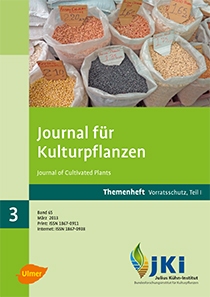Biological Control of stored product pests using the parasitoid <em>Lariophagus distinguendus</em>: Past, presence and future
DOI:
https://doi.org/10.5073/JfK.2013.03.07Keywords:
Biological Control, stored product protection, ecological farmingAbstract
The Pteromalid wasp Lariophagus distinguendus develops as ectoparasitoid in larvae of several stored product pests. Therefore, in 1919 Prof. Dr. Albrecht Hase from the Biologische Reichsanstalt für Land- und Forstwirtschaft in Berlin suggested its use for the Biological Control of these pests. Russian studies on the host finding ability of L. distinguendus in the 30ties were followed by extensive studies on several aspects of the biology of the species in the 50ties by Kashef and in the 70ties and 80ties by van den Assem, Bellows and Charnov. The latter made L. distinguendus famous as model organism in behavioural biology. Around the beginning of the 90ties a group from Korea studied the ecological interaction of L. distinguendus with its hosts and with competitors. Due to the need of alternative, environmentally friendly methods for the control of stored product pests, the idea of Biological Control with L. distinguendus was revived in 1994 in Berlin by scientists from the Angewandte Zoologie of the Freie Universität Berlin, the former Institut für Vorratsschutz der Biologischen Bundesanstalt, and the company BiP-Biologische Beratung bei Insektenproblemen. Their studies revealed that L. distinguendus is able to locate granary weevil infested grains up to 4 m deep in the grain, and that it is able to reduce population growth of granary weevils by 94%. Based on these results, L. distinguendus is commercially available by several companies. Current studies on L. distinguendus are conducted at the Institut für Zoologie of the Universität Hohenheim in Stuttgart. The goal is to improve the mode of application by using a rearing box, which can be placed in the grain store. Furthermore, the use of L. distinguendus in empty grain stores to control residual populations and its dependence from extreme temperatures in summer and winter is studied.
Downloads
Published
Issue
Section
License
The content of the journal is licensed under the Creative Commons Attribution 4.0 License. Any user is free to share and adapt (remix, transform, build upon) the content as long as the original publication is attributed (authors, title, year, journal, issue, pages).
The copyright of the published work remains with the authors. The authors grant the Journal of Cultivated Plants, the Julius Kühn-Institut and the OpenAgrar repository the non-exclusive right to distribute and exploit the work.







